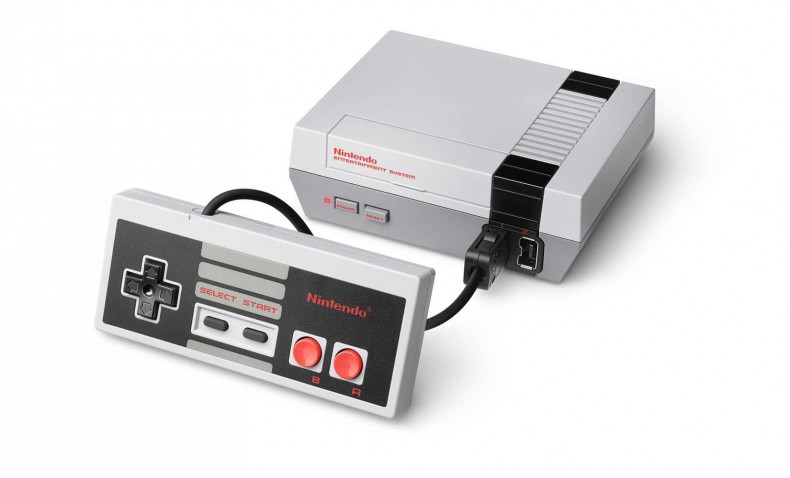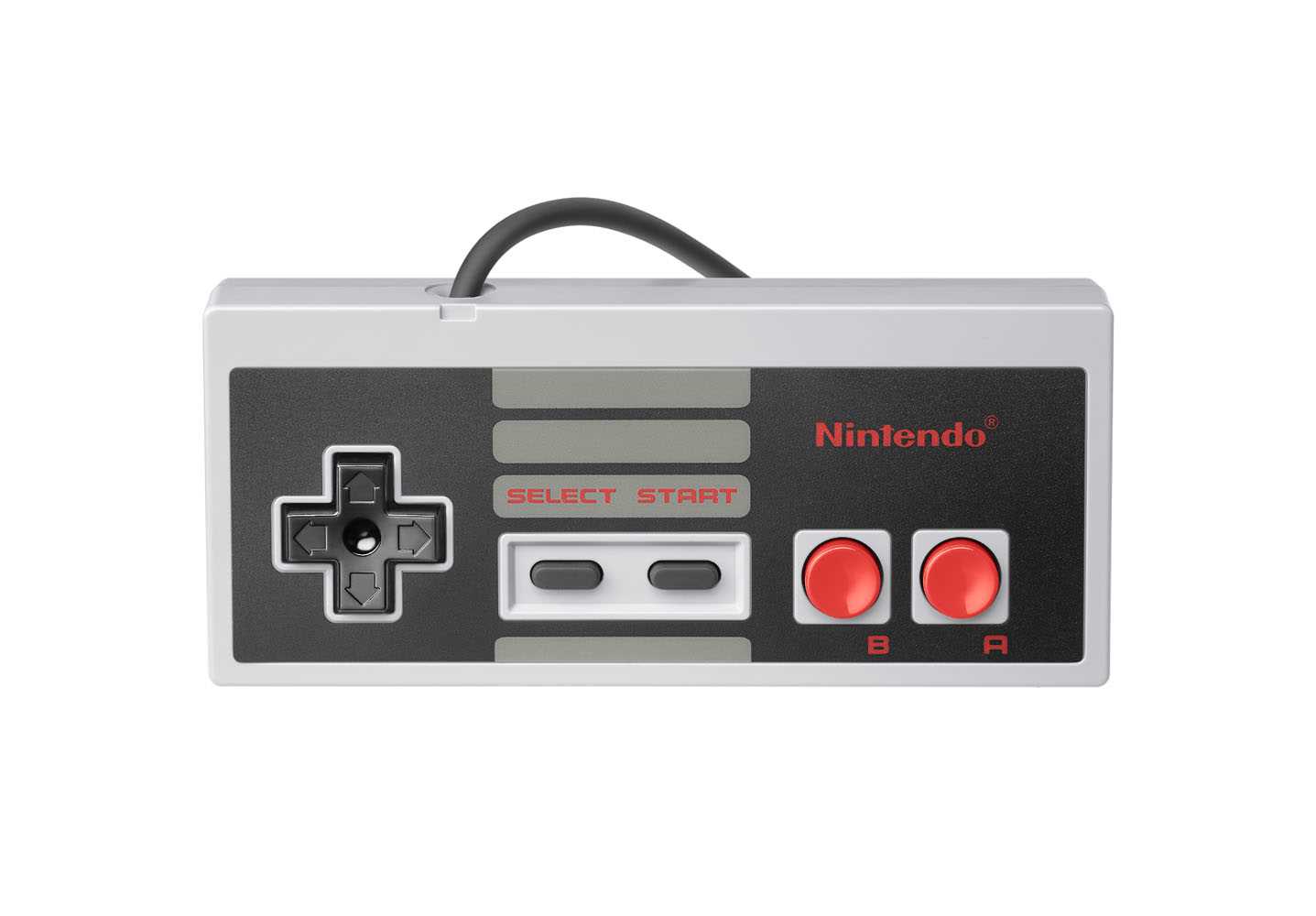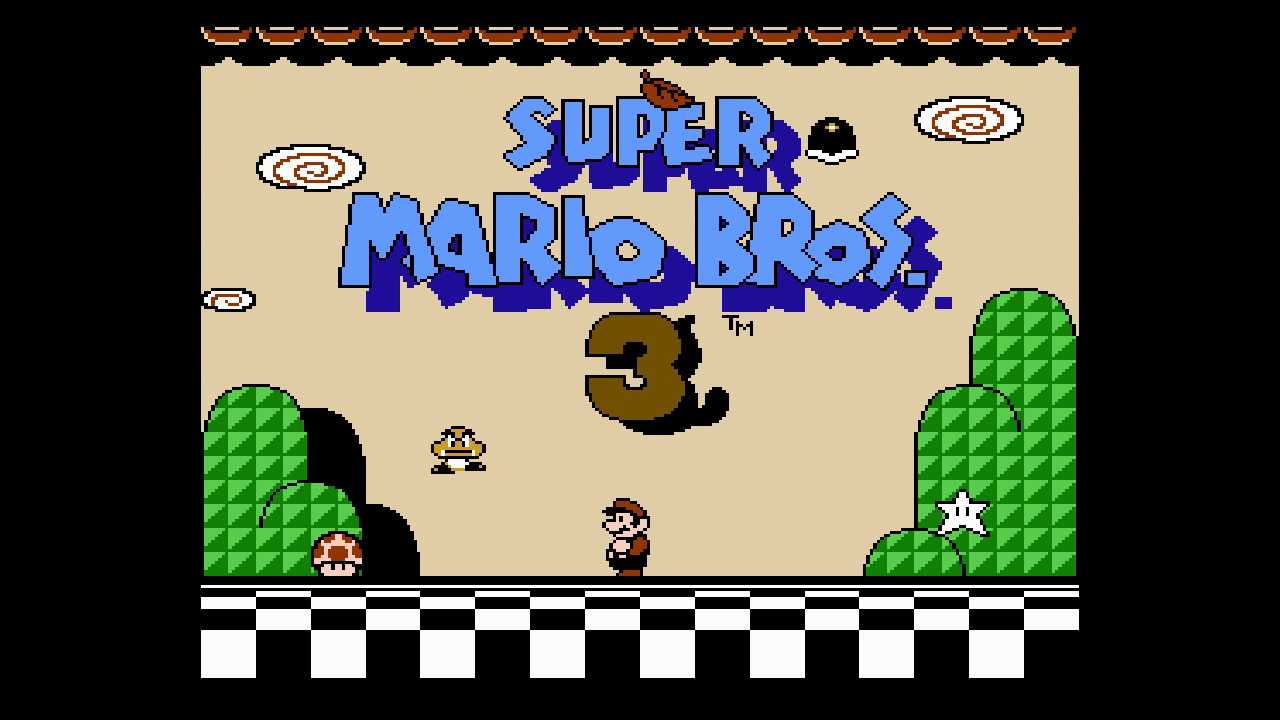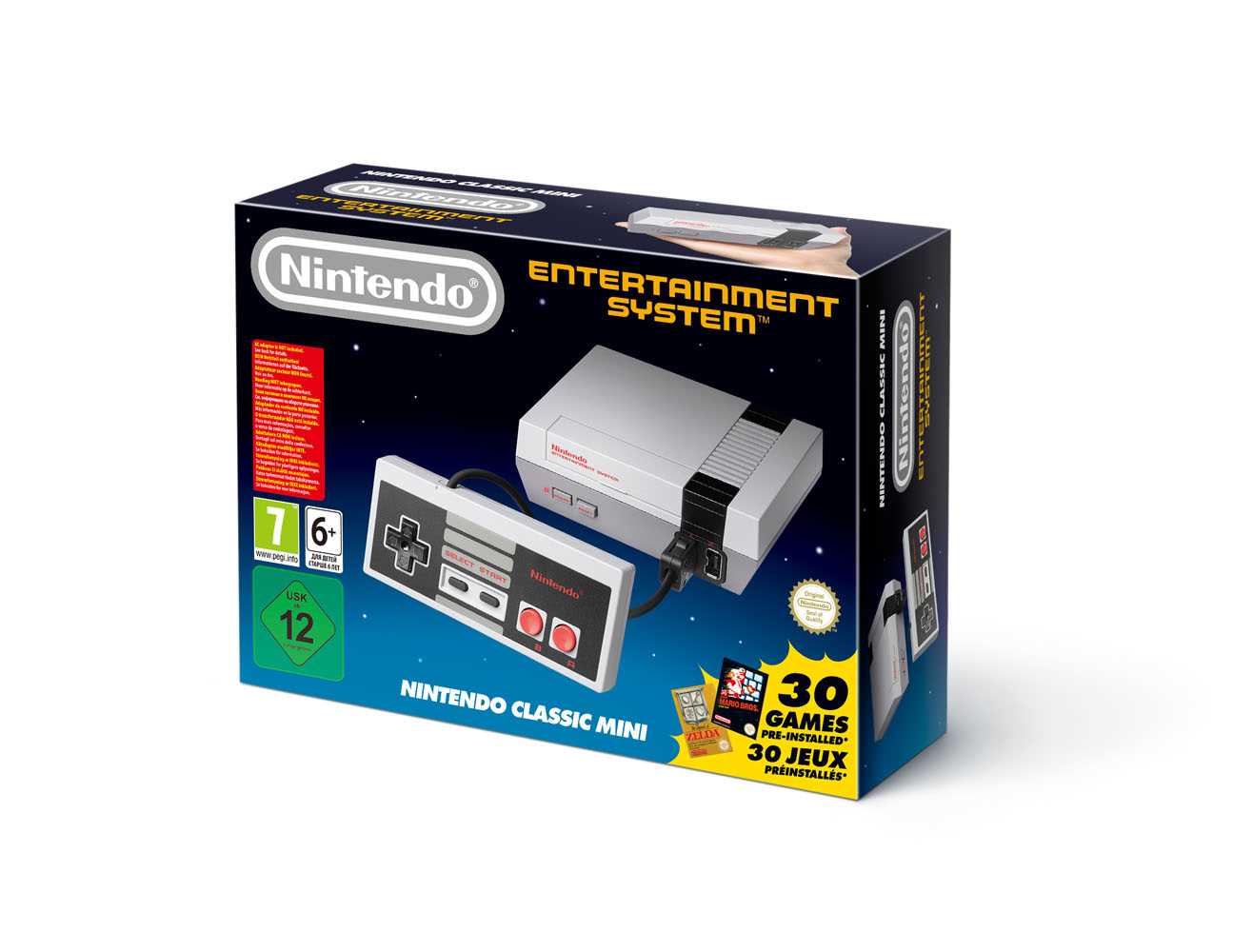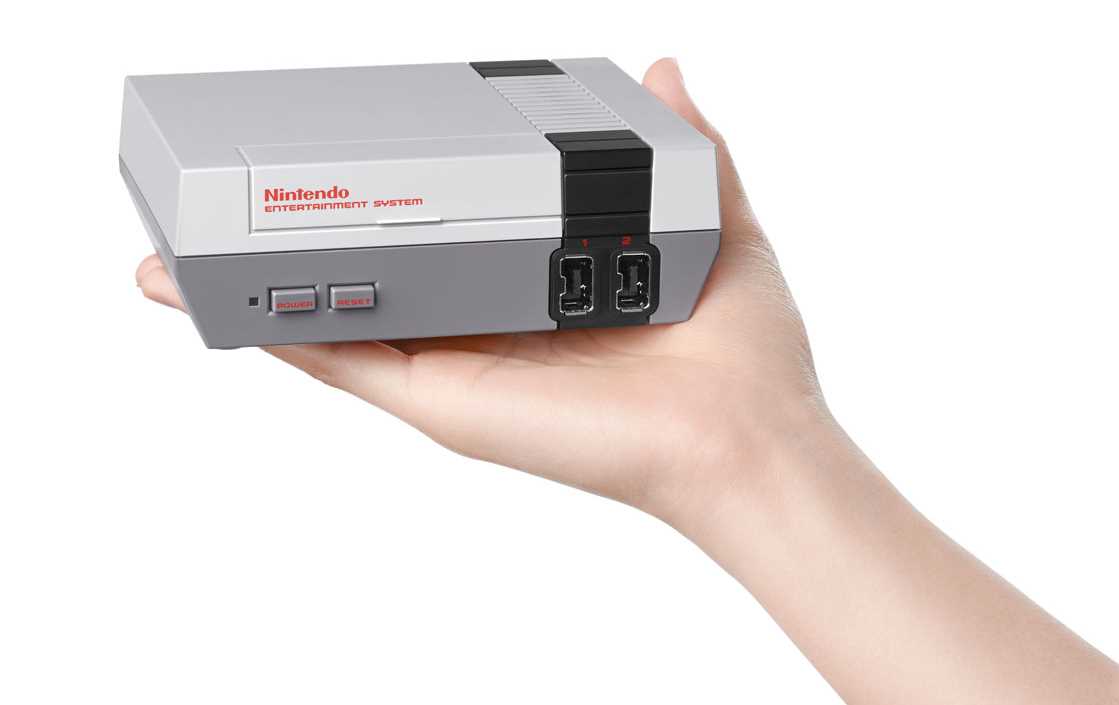Released in North America in 1985, and European territories throughout 1986 and 1987, the Nintendo Entertainment System is a true classic of console gaming. It single-handedly rescued the North American console market from its crash, years prior. It introduced the world to Super Mario Bros., The Legend of Zelda, Metroid, Mega Man, Castlevania, and hundreds of other series that helped make the games industry what it is today.
This boxy grey lump of plastic has become an icon in gaming. It put Nintendo on the map, and became synonymous with videogames in the 80’s and early 90’s. Thanks to 80’s nostalgia, after 30 years it has come back. But now, it’s tiny. I mean really tiny. Despite the original console’s size, the NES’s internals are mainly empty space – but even with that said, it’s impressive to see how much smaller this new version is. It’s tinier than a NES cartridge.
It’s packaging is just wonderful. It’s styled to look exactly like the cardboard boxes we ripped open to get to our original NES consoles, and it only helps to drop this enormous nostalgia bomb. Once you shed the Classic Mini of its wood pulp-based prison, you’ll find an affordable little box of tricks, one that is incredibly simple to setup. The included USB cable is used to power the system by plugging it into a USB port on your television, but if you don’t have the ability to do that, you will need to buy a 5W USB to AC adapter to plug the device into the mains. With so many televisions having at least one USB port, hopefully this shouldn’t be an issue for most people, but it’s a little irritating that it doesn’t come with a proper power supply. Once you’ve sorted out your power, plug a HDMI lead from the system to the TV and you are good to go. It’s pretty effortless, which is really going to help when you attempt to set the console up at Christmas after a few brandies.
In the box is also a controller, which actually has the same plug as the Wiimote’s external controllers, meaning you can use it with your Wii or Wii U for Virtual Console gameplay. Unfortunately, the cable length leaves a lot to be desired, especially when compared to the original pad’s cable length. You should be able to get some cable extenders online, but it’s still a puzzling decision by Nintendo. If you’re after some two-player action, you’ll also need to buy another pad separately.
However, it’s worth mentioning that the Nintendo Classic Mini will work with pretty much any Wiimote external Controller, whether it’s the Classic Controller, Pro Controller, or even the Club Nintendo-exclusive SNES controller. Sure, it’s not in keeping with the authentic experience, but it’s cheaper than buying a new controller if you already have one of these pads around. The included controller, apart from the shorter cable, is identical to the original’s iconic design – including those lovely sharp corners.
Turning that Power button on loads the Nintendo Classic Mini’s simple menu. Here you can select one of the 30 pre-installed games, change your display settings and even enjoy a quirky demo mode that features some very “Nintendo” animated scenes. It continues the simplicity and uncomplicated nature of the Nintendo Classic Mini, and just lets you get straight into playing a game without too much faffing around.
While it’s a shame that it’s impossible to play original NES cartridges on the Nintendo Classic Mini (unsurprising, considering that NES carts are considerably larger than the system), or even add more games, the 30 games that are preinstalled are a brilliant representation of the system’s library. Of course, you’ve got the entire Super Mario Bros. and Zelda series here, but there’s also a selection of Nintendo’s not-so-popular releases like Punch-Out!!, Kid Icarus and Balloon Fight. Rounding out the collection are a number of superb third-party releases, like Double Dragon II, Final Fantasy and Mega Man II. It’s not a perfect list by any stretch – It’s puzzling to see Super C on this list rather than the original Contra/Probotector, and I wouldn’t say that Tecmo Bowl is relevant to most people outside of America, but as a whole it’s a fine list of games that offer a nice cross-section of what the NES gave us.
Emulation will never fully be able to recreate every nuance of a console, but with the NES Classic Mini, every aspect of the 30 original games are relatively well-replicated, even down to slowdown and the lines of garbage that are displayed in scrolling games – plus, it far exceeds the quality of previously emulated Virtual Console releases. In those Wii, Wii U and 3DS digital re-releases, there’s a real issue with washed-out colours, which Nintendo have finally rectified for the Nintendo Classic Mini. Because this newer system outputs via HDMI at 720p resolution, you’re looking at an incredibly clean picture, with pixels that really pop. Via the menu, you have the option of displaying the system in various different aspect ratios. You’ve got a 4:3 option, which should be familiar to anyone who’s ever used a standard non-widescreen television, as well as a pixel perfect mode that is more square, but is a perfect reproduction of the original system’s 256 x 240 display, scaled up to fit modern resolutions. Finally, there’s a CRT filter, which adopts the 4:3 ratio option, but adds a filter to make it look like it’s running on a poor quality analogue display, complete with scanlines and noise. It’s cool for a few minutes, but you can get better quality output from a real NES, so it’s not a mode that you’ll be playing with for any stretch of time.
Let’s talk about how it compares to a real NES, shall we? The original Nintendo Entertainment System gave you two choices for outputting video, out of the box. The first is via an RF connection, which gives you the worst quality video you can possibly imagine. The alternative is using a composite connection over RCA or SCART cables, which gives you a better quality picture, but it’s still not amazing. In recent years, people have modded NES consoles to output using superior RGB SCART connections, and more recently, it has become possible to mod a HDMI connection that outputs at a full 1080p resolution and will even add scanlines. However, these modifications cost more than twice the amount as it does to buy a Nintendo Classic Mini, and that doesn’t even include the increasing cost of buying an original NES console. It’s also worth noting that original NES consoles released here in Europe were locked at a 50hz signal, meaning our games were not only slower, but were riddled with black borders.
I have an original American NES console running through a composite connection, connected to my television by a dedicated retro console upscaler unit, and I’m pleased to say that the Nintendo Classic Mini betters my original unmodded NES console in every way, with the colour and clarity being far improved on the newer console. As alluded to earlier, to get the same sort of video quality from an original system, you’ll need to either get your system modified with a HDMI output, or use a combination of an RGB SCART modification and a video upscaler – so the Nintendo Classic Mini is an easy way to get the perfect NES setup with a vastly reduced cost.
Comparing it to the Wii Virtual Console’s representation of the NES, once again the Nintendo Classic Mini comes out on top, even when running the Virtual Console via the Wii U’s HDMI output. When you consider that each NES Virtual Console game costs at least £3.50 on the 3DS eShop and around £4.50 on the Wii U eShop, the NES Classic Mini clearly offers a fantastic deal.
But as much as the emulation is almost perfect, the hardware itself isn’t. In fact, the system’s main faults stem from some puzzling design choices, mainly revolving around the Classic Mini’s reliance on mimicking the past system. As previously mentioned, the controller cables are incredibly short, which can prove to be a problem for those of us who sit a distance away from our gigantic flat-screen televisions. Another issue is that to get to get to the main menu you need to walk up to the Classic Mini and press the Reset button. Would it have been difficult for Nintendo to slightly amend the original NES controller design and hide a menu button on there somewhere? The issue is remedied somewhat by using a Wii Classic Controller or Wii Pro Controller, as the Home button can be used to get to the menu screen, but then you’re missing out on using that authentic controller. I wonder if the ability to use wireless controllers would have been a better idea? It’s also a shame that there isn’t a way to purchase more games – with NES games being so tiny, it would have been great to have some sort of internet access and purchase new games for a low price.
However, I can see why such mod cons weren’t considered, as the NES Classic Mini’s intention is to be a cheap and easy nostalgia fix for those who were around when the original system ruled the roost, or for those who weren’t old enough to remember the 8-bit generation and want to discover these classics for possibly the first time.
Purists may prefer the expensive option of buying a HDMI-modified NES, but for those who fancy a quick go of Bubble Bobble or Castlevania every once in a while, this pint-sized system is more than suitable for the job – and those 30 games will keep you going for quite a while.
With this system selling out even before release, I hope it’s success gives Nintendo a reason to delve into their hardware library for more Classic Minis. I know I’d love a SNES Classic Mini.
Almost perfect emulation
Simple to setup and use
Features a good selection of classic NES software
Some odd game choices
Cable lengths are a real issue
No facility to use proper NES cartridges
Issues with cable length aside, this is the perfect Christmas present for any retro gamer.


